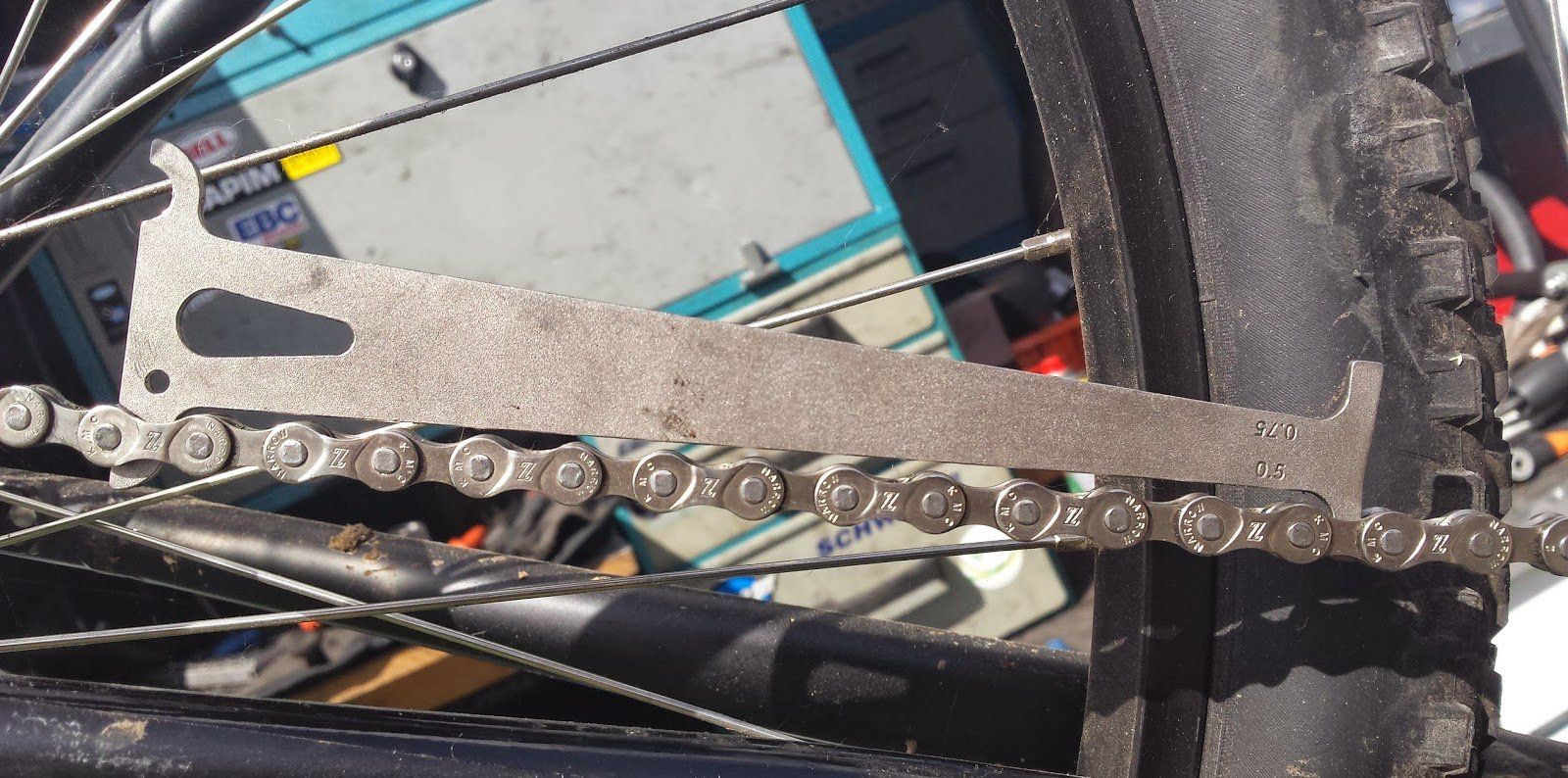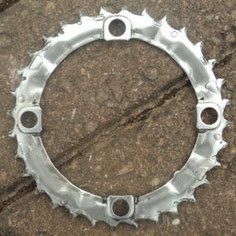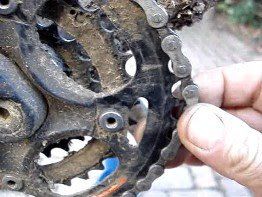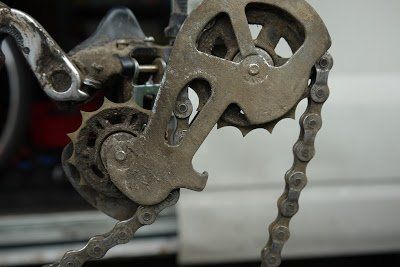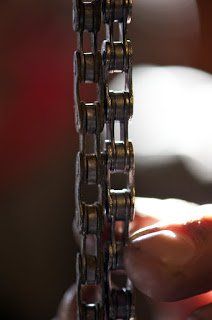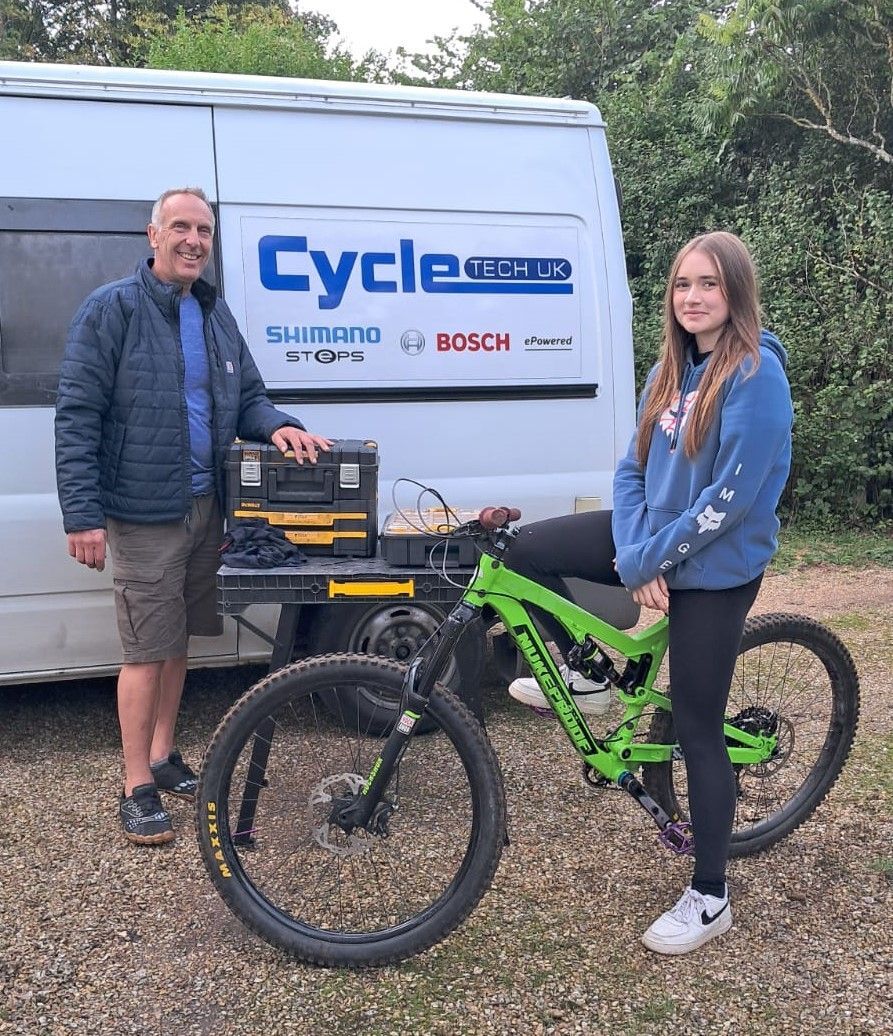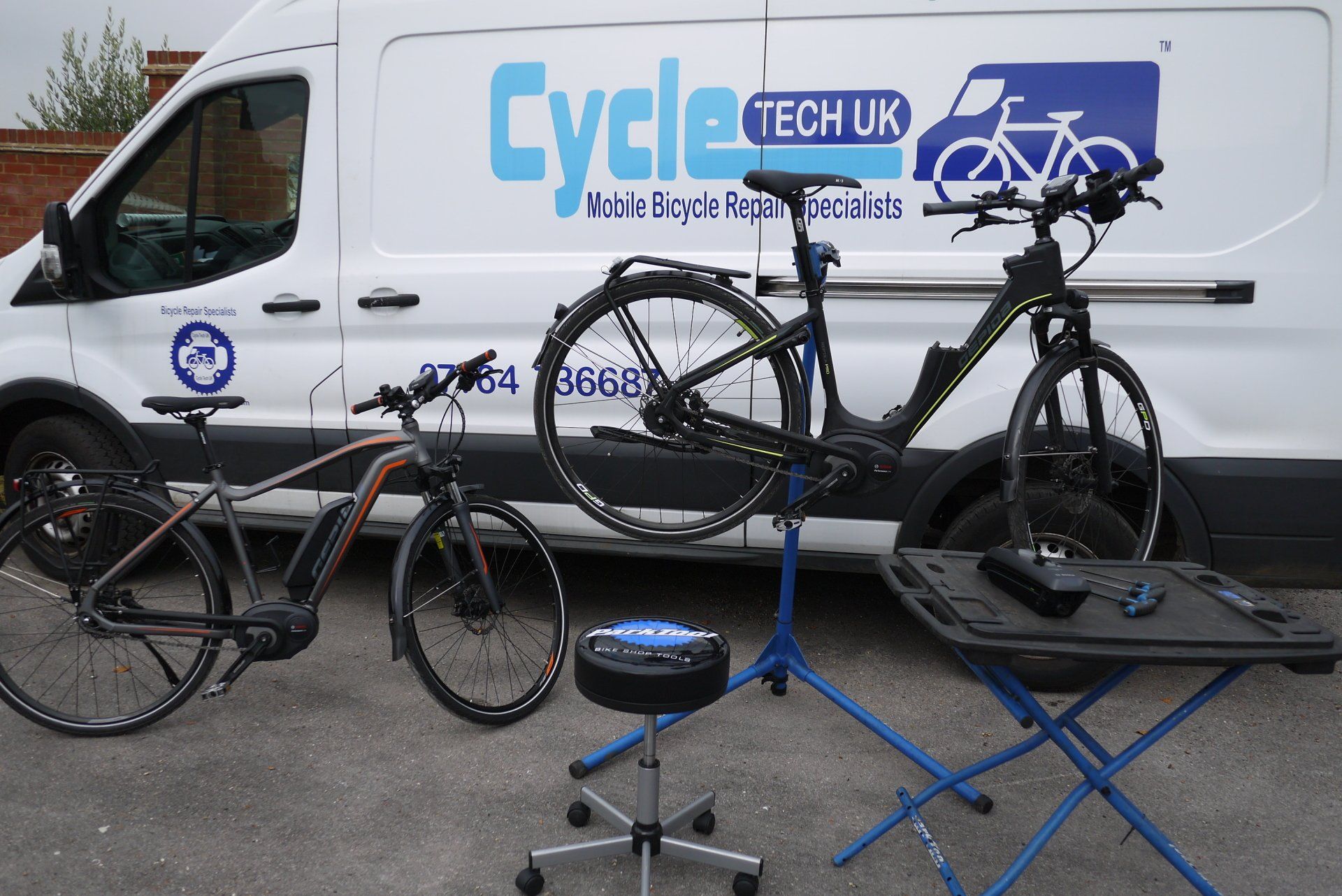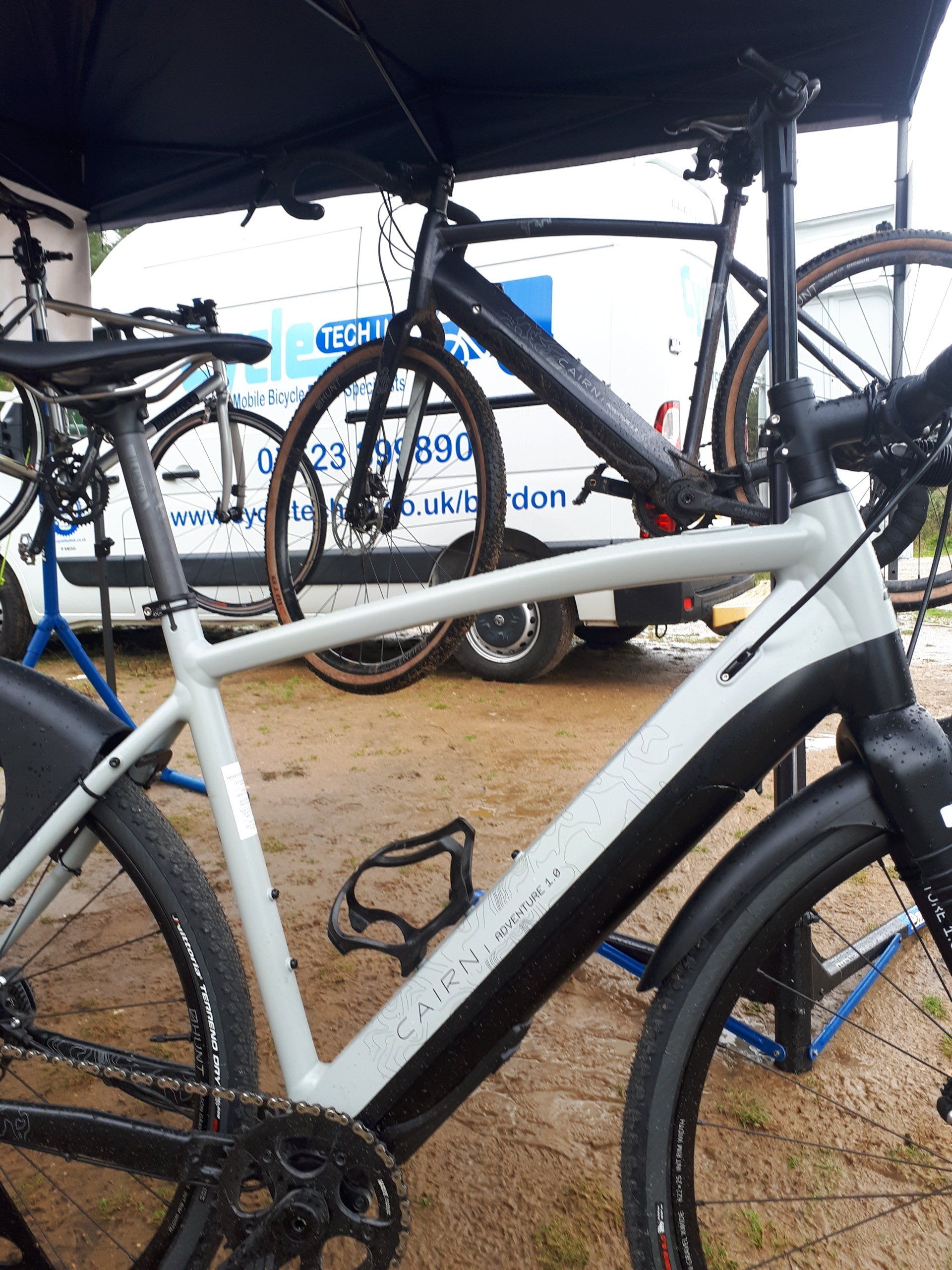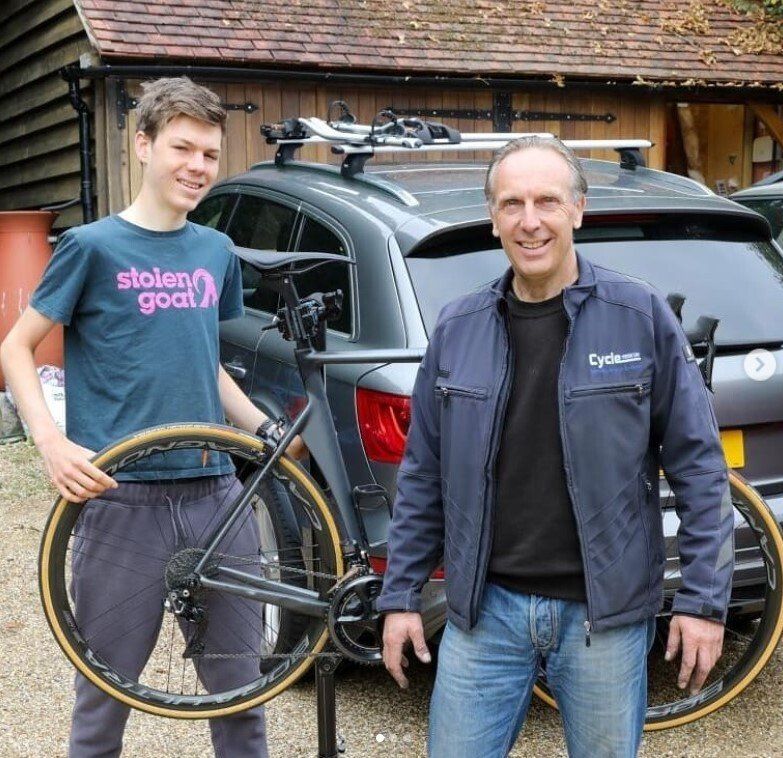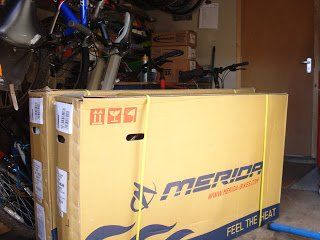Chain Care & Wear
martin wilkins • October 30, 2019
A worn chain: Cyclists often speak of chain stretch and removing a link or two will fix the problem. This is not true!
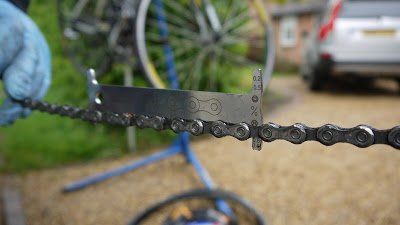
The major cause of chain stretch is wearing away of the metal where the rivet rotates inside the bushing and not the side plates of a chain.
The effect of wear on a roller chain is to increase the pitch (spacing of the links), causing the chain to grow longer. Note that this is due to wear at the pivoting pins and bushes, not from actual stretching of the metal. The sprockets (in particular the larger of the two) suffer a grinding motion that puts a characteristic hook shape into the driven face of the teeth. (This effect is made worse by a chain improperly tensioned, but is unavoidable no matter what care is taken). The worn teeth (and chain) no longer provide smooth transmission of power and this may become evident from noise or chain slipping under load (Cycling uphill or cycling when standing up)
Chain wear indicator tool.
Is only used to indicate chain wear before it wears out the chainrings or before the chain brakes, after that point, it's too late and the tool is not required.
You can save money by caring for your bicycle between regular servicing.
Chain wear indicator tool should be used regularly by the owner or at regular service intervals.
For 7 to 10 speed chains:
If the indicator shows a reading between 0.5 - 0.75 worn, the chain should be replaced soon, before other components also start to wear out fast.
If the indicator shows 0.75 - 1.0 + worn then chain and cassette should be replaced together to avoid wearing out the chainrings and the new chain slipping on the old cassette.
Replace chain and cassette approximately no later than 2000 miles. This will depend on the use, conditions, cleaning and the type of oil used.
After replacing just a chain, then performing a road test, this would show if the chain runs smoothly on the old cassette as both may need changing, especially where the cyclist only uses one or 2 of their favorite sprockets/gears.
Whether the cassette needs replacing, will depend on how you ride, if you are in the high gear (the smallest cog) all the time. Then this will wear out the teeth on the sprocket and will require replacing the cassette.
For 11, 12 speed chains, ebikes and x 1 speed chain systems:
If the indicator shows a reading between of 0.5 worn, the chain should be replaced soon, before other components also start to wear out fast.
If the indicator shows 0.5 - 7.5 + worn then chain and cassette should be replaced together to avoid the new chain slipping on the old cassette and rapid wear to the new chain. Also the chainring should be checked and replaced if signs of wear or on road testing any noise or chain suck.
Replace chain & cassette approximately no later than 1500 miles. Ebikes replace chain approximately every 400 miles and cassette when necessary.
Chain wear indicator tool reading: ☺ 0 0.2 0.4 0.5 0.75 1.0 1.0 + ☹
0.75% = 1.59 mm wear per 300 mm of chain length. (1/16" per 12" or/24 links)
Campagnolo say:
All Campy chains last between 2,000 - 5,000 miles As to Campagnolo wear check - Campagnolo recommends a chain longer than 132.60 mm (at 6 outer links) the chain must immediately be replaced.
To prolong the life of an eBike chain or x 1 system chain:
- Change 1 gear at a time. Sram now upgrades eBikes to a 1 change at a time shifter.
- Having mudguards fitted will help keep the chain clean
Why replace chain and sprockets at the same time?
Both sprockets and chain should be replaced in these cases since a new chain on worn sprockets will not last long and a new chain will eventually start jumping on the worn teeth of the cassette/freewheel.
Note:
Some new bikes are fitted with poor quality parts and when checking a chain for wear, it will show wear at 0.5. KMC chains that are of poor quality will be marked with a "Z" on the chain. All other KMC Chains are high quality and good bike shops will stock KMC chains marked with an "X"
The rear derailleur
A rear derailleur has two main functions;
- To move the chain from one sprocket to another.
- To keep the chain under tension as you change gear from a large sprocket or chainring to a small sprocket or chainring. Or you would end up with a chain flopping around. So as your chain "stretches" the rear derailleur will take up the tension!
Other components that also start to wear out:
If you don't change your chain in time and continue to ride your bike, you won't only need to replace your cassette but also your chainset and jockey wheels often at great expense!
Worn teeth on the middle chainring
The teeth on this chainring are pointed like sharks teeth and hooked by a worn chain. This will also be caused by only using the middle chainring and not changing gear. (A common cause of chainring wear.) Chainrings can be replaced individually, on low-end bikes it normally makes sense as it's cost effective to replace the chainset.
Worn chain, lifts easy from chainring
Though skipping caused by worn cassette cogs and chain, skipping can occur when chainrings are worn out too. (When the teeth look like sharks teeth)
Teeth on jockey wheels worn
These jockey wheels have worn from by riding a bike with a worn chain, from lack of cleaning and lubricating. The teeth will thin and become pointed, especially the lower pulley. Worn pulleys will not be able to hold or guide the chain as well as newer pulleys, and shifting performance will suffer.
If your gears have become noisy or the chain is jumping, it is time to have your bicycle serviced/inspected to avoid wearing out your complete drive chain at extra cost.
Lubricating:
Regular lubrication with a suitable chain lubricant is essential and you should also consider replacing the chain on a regular basis to prevent it from wearing out the chainrings as quickly. The cardinal rule for long chain life is never to lubricate a dirty chain, as this washes abrasive particles into the rollers and acts like an abrasive paste. Chains should be cleaned before lubrication. The chain should be wiped dry after the lubricant has had enough time to penetrate the links.
Gear Adjustment (Cable operated):
Indexing: If a derailleur is correctly adjusted when it is installed or serviced this is the only adjustment that should have to be tweaked, later on, to accommodate cable stretch.
Gear cable adjustment for 9 & 10 speed rear derailleur every 500 miles. For 11 speed every 400 miles.
Using derailleur gears:
Not using your gears correctly will wear out your sprockets/chainwheel.
Keep pedalling forward. A derailleur leads the chain from one sprocket to another. The chain can only move sideways while it is also moving forward. For this reason, you can only shift while you are pedalling forward. The rear derailleur can usually shift under full load, but it is better for the chain to ease up a bit during the shift.
Even though a bike is "21 speed", it will not have 21 gear ratios with consistent steps between them. You are likely to find that the ratios on the middle chainring are closely duplicated by the gears on the smaller and larger chainrings.
For a "21 speed" bike, you have 3 ranges of 7 gears, NOT 21 gears. The ranges exist to minimize the amount of front derailleur shifting that is required.
Cycle Tech UK suggests quite sensibly, that you avoid using the "extremes", i.e. the smallest chainring with the smallest rear sprocket and the largest chainring with the largest sprocket. Using these combinations can lead to premature wear on your chain and sprockets.
What else to look out for:
Gear cables:
Are the most common cause of incorrect gear operation. Gear cables can become kinked, corroded and your gear shift will not be smooth adding wear to chain and sprockets. Cycle Tech UK recommends lubricating, inspecting cables regularly and replace once a year. Bike design's and rooting of cables though handle bars and frames is making it much harder to inspect cables for damage and wear, so cables should be changed regular to reduce failure.
Gear Hanger:
Before you try to adjust your rear derailleur, you should really make sure it isn't bent. The rear derailleur is the most fragile and exposed part of a bicycle, and they are always getting knocked. Aluminium frame bicycle have a gear hanger to stop damage to the frame, which the derailleur is bolted to.
When a derailleur hanger is bent, it is generally necessary to remove the derailleur to straighten it. Cycle Tech have a special tool, a bar with a sliding gauge on it, that screws into the hole in the hanger in place of the derailleur. This tool provides lots of leverage to straighten the hanger with, and has a gauge to judge when it is parallel to the rear wheel. A rough, on-road repair is sometimes possible by removing the derailleur and bending the tab with an adjustable wrench.
To view service intervals and whats included in each service type. See Price Menu
for full details.
To learn to maintain your own bicycle, you can now learn with Parktool Home Mechanics School
Home mechanic Video - Chain care between servicing
For long life and smooth gear change, it's important to keep your drive-train cleaned and oiled regularly.
Tools: Degreaser, brushes, scraper, clean rags and lube (Use wet or dry lube to the conditions and time of year)
When using dry lube, shake the bottle well before applying and leave for 6 hours to dry.

The key to successful business; to deliver above and beyond customers expectations. We know this as aftercare. Our network established itself by offering a premium personal service. The delivery of this means CTUK is known for excellent values and customer service, including the industry standard and ‘M-Check’ - Going the extra mile.
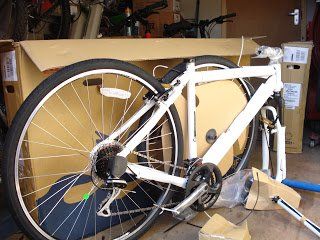
Cycle Tech UK is advising cyclists to have a home visit when their new bike arrives to have it set up and explain how everything works. Cycle Tech UK also can arrange the fist service to make sure everything is running smooth, items like cables, crank bolts and steering require adjustments at 30 days.
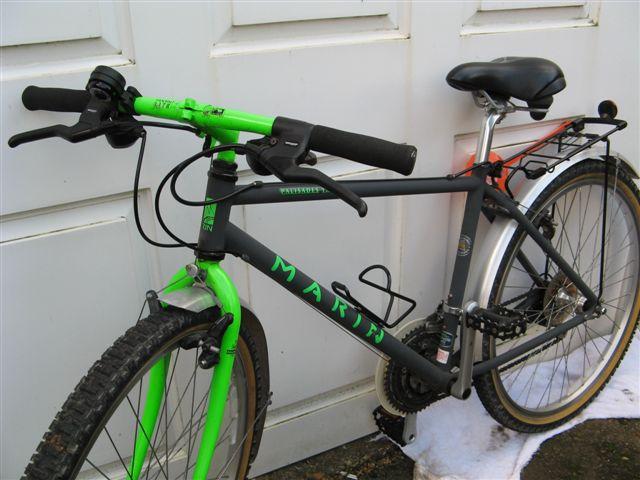
When looking for a bargain, it is likely these days that you will turn to eBay for a second-hand bike. While there are bargains to be had, when buying a second-hand bike, you need to be careful, because you may have a large repair bill to go with the bargain price. Even if the person is not intending to be dishonest, their idea of the perfect condition may mean clean but worn out. In recent weeks two of our repairers have given out bills of well over £100 to make a bike usable, even though they were described as "good as new".

Bike out of the box. More than just turning the handle bars and fitting the peddles. Professional assembly of your bicycle purchased online It may be your first or a repeat online purchase, but it is vital your new bicycle is professionally assembled before using it. This is known as a Pre-Delivery Inspection (PDI) that requires proper assembly of your new bike from a box. Parts require checking using a torque wrench and checks must be made to ensure critical components are set up correctly. This will ensure the bike is safe, giving it long-life and for you to have continued enjoyment. The internet is where most people go to for the best deal When you buy your new bike online it will be shipped in a box. A supplier will advise to; "Just turn the handle bars, fit the peddles and you are ready to go" Are you? It is essential that a professional checks your bike first. Checks before dispatch by the supplier, do not guarantee your safety after handling in transit. Consider this very carefully as bicycle accidents can hurt! Tip: When buying your new bicycle factor in the service and maintenance costs. Pose a real danger to yourself and others Doing it yourself means you need the correct tools. A torque wrench or know the feel for how tight the bar stem/bars, the steering, peddles and seat post bolts should be. Know how to set up the ride potion, to know if a component is functioning correctly, requires adjustment or has been damaged when being delivered. Cyclists call us when it goes wrong Quit often a customer brings a new bike in for repair they just brought online, saying the gears are not working correctly. On a closer inspection, the bicycle shows up more issues; misalignment of critical components, brakes rubbing, rounded of hex key bolt heads, loose steering and even the wrong size bike. Our Technicians are always on-hand to get you back on the road, as soon as possible in a safe manor. The way we can get involved with a bike that has not been PDI'd by a professional, means carrying out a full PDI to make sure the bike is safe to be used on public roads after being seen by one of our Cycle Technicians. Part of the PDI processes is the hand over, making sure the rider knows how to use the gears, when to check the tyre pressure and to what pressure, how often the chain needs oiling/cleaning and when the bike requires servicing. For ebikes; advice is given on charging and storing the battery for reliability and long-life. Or this can mean an expensive non-warren replacement, if not maintained as manufactures recommendations. 'Good Practice' The bike trade also recommends a first service at 30 days from date of purchase, to make sure everything is running smoothly and make miner adjustments of brakes and gears, plus check the steering, wheels, crank for fitment and correct operation. Its even more essential that ebikes are inspected more often. Particular the brakes and chain for wear. ebikes are much heavier on the brakes and drive-chain and require replacing parts more often, before wearing other associated components or complete failure, resulting in a expensive overhaul to bring the bike back to good working order. This Is What Cyclists Are Saying When They Contact us: "The pedal come out! Its only 6 weeks old." "Had gear issues for ages, had a new derailleur fitted few weeks ago, still felt dodgy, bikes only 3 months old, just bought new shifter and cable and need them fitting and gears sorting, new headset, and rear wheel bearings looking at" "Bike has got stuck in highest gear. Thought the suspension lever was the gear lever. Never heard of that before"

